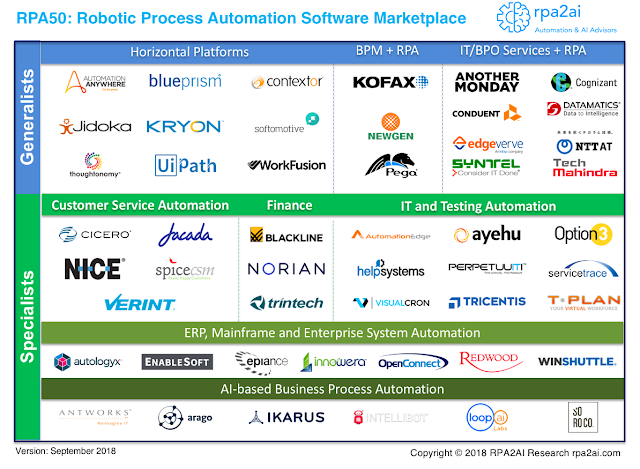RPA is an imaginative acronym that alludes to robots, but reality is more prosaic. RPA or Robotic Process Automation actually refers to software that automates the repetitive tasks performed by office employees. RPA robots are designed to mimic the tasks performed by humans on their computers once they have been trained or programmed. The training of these "bots" implies showing them the steps of a workflow or a business process, such as opening a website, entering data and clicking on the screens. Once the sequence is recorded, it can be replayed as many times as necessary. RPA tools do not alter your existing IT systems, but use the same systems (for example, CRM, ECM) that your human colleagues already use.
Where is RPA used?
This type of "recording and playback" approach to automation is not new. But when such automation centered on the user interface is used in conjunction with capabilities such as optical character recognition (OCR), the RPA software becomes a powerful and versatile tool. RPA can be used to automate standardized activities or controlled by rules that are currently performed manually. However, if there is an update of the underlying applications (for example, a new version of the ECM software released) or a change in the business process, you must redo the RPA robots.
 |
| Robotic Process Automation Software |
RPA is different from AI
RPA is not the same as an artificial intelligence system (AI). RPA tools should have a script / show what should be done, while AI systems learn by analyzing data and can make recommendations. In addition, AI can handle unstructured data while RPA operates with structured data. That said, RPA can be a future gateway for the adoption of AI in the company, since suppliers add AI modules to RPA products.
Business Case RPA
The business case for RPA focuses on improved productivity, greater efficiency and cost reduction. I do not want to go around the bush: these benefits are derived from the automation of human tasks, that is, the use of fewer employees to do the same job. Of course, RPA can also free people to do more value-added jobs than highly repetitive tasks. Keep in mind that most organizations are currently only piloting RPA projects and have not reached the level of scale at which they begin to choose the type of "human worker versus digital robot".
High level of customer interest in RPA
RPA can be a simple technology, but it has the potential to be a game changer for several business processes such as customer support, finance and accounting, human resources operations, case management, document processing, etc., in a wide range of industries. It is not surprising, then, that virtually all large organizations are considering or implementing RPA. In fact, RPA is one of the fastest growing (if not the fastest) business technology categories for both RPA software and RPA professional services.
Experience in limited internal RPA
As RPA is a relatively new area that is experiencing rapid growth, client organizations do not have much internal experience in RPA. The selection of the right partners thus becomes a critical success factor. The RPA market itself is highly dynamic and is evolving rapidly. When it comes to professional services, all large consultancies, systems integrators and local actors have developed large RPA practices. RPA projects are not just technology implementations, but they involve a process transformation and a large amount of change management. Consider these aspects when looking for a service partner.
RPA product providers
You also have many options when it comes to RPA software providers. There are horizontal platforms, which are suitable for a wide range of use cases of automation in all industries (for example, Automation Anywhere, Blue Prism, Kryon, WorkFusion, UiPath) but there are also specialists who focus on specific functions and cases of use. There are also traditional BPM providers that expanded to RPA and service firms that developed their own products. See the attached chart for different categories of suppliers and examples.
Selection of RPA technology
When selecting an RPA provider, consider the main functionality of the RPA product and match your automation use cases. Also evaluate the ecosystem around the product, its service partners and the finances of the company. It is not uncommon to find companies that use a "best in class" strategy and that select multiple RPA providers. Keep in mind that many vendors are rooted in the automation of desktop computers and are still discovering how to make their products truly enterprise-class.
Conclusion
RPA is beginning to have an impact on the automation of office work. The current pilots offer an advance of the potential of RPA. The selection of the right professional services partners and the selection of the appropriate RPA technology are critical factors for the successful implementation of RPA throughout the company.





1 Comments
Good post! thanks for geving this information...
ReplyDeleteRPA Training in Bangalore
RPA Courses in Bangalore
RPA Classes in Bangalore
AWS training in bangalore
AWS courses in bangalore
AWS classes in bangalore